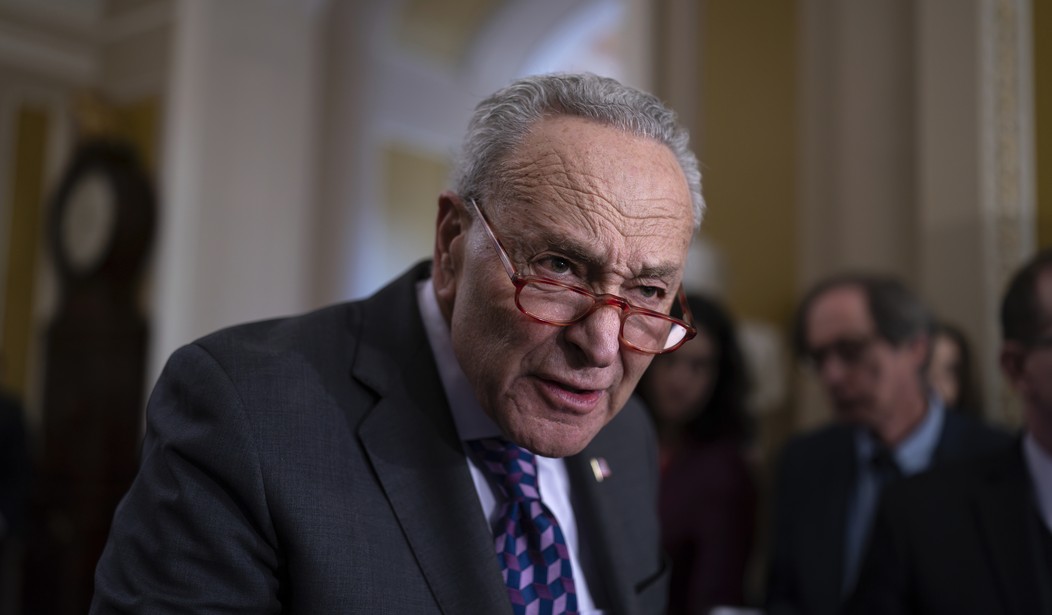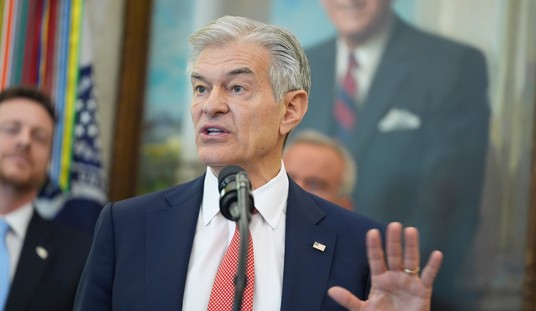While the 2022 Midterms turned out to be a disappointment for the GOP, it was always going to be a bit more challenging than this year for Republicans to take back control of the Senate. This election year, chances not only look good, but they're looking increasingly better for the right. This not only concerns races Republicans are defending but ones they're looking to pick up from Democrats.
On Thursday, The New York Times/Siena College released Senate polling on Texas, Montana, and Florida. Not only do all Republicans have an edge among likely voters, but a headline for The New York Times declared, "Republicans Appear Poised to Take Control of Senate, New Poll Shows."
In Texas, Republican Sen. Ted Cruz leads Democratic Rep. Colin Allred by 48-44 percent, while Republican Tim Sheehy leads Democratic Sen. Jon Tester by 52-44 percent in Montana, and Republican Sen. Rick Scott leads Democrat Debbie Mucarsel-Powell by 49-40 percent.
The poll results quickly became a trending topic on X for Thursday.
#New @nytimes Senate Polls
— Political Polls (@PpollingNumbers) October 10, 2024
Texas - 🔴 Cruz +4
Montana - 🔴 Sheehy +8
Florida - 🔴 Scott +9
Siena #A+ - LV - 10/8
The write-up starts with a focus on the Sheehy-Tester race, with Tester looking to be the Democrats' most vulnerable incumbent, especially with West Virginia's Joe Manchin, now an Independent, having announced last year he was retiring. With a Sheehy win, Republicans could gain back control of the chamber.
Recommended
As the write-up mentions:
Control of the Senate appears likely to flip from the Democratic Party to the Republican Party this fall, as one of the nation’s most endangered Democrats, Senator Jon Tester of Montana, trails his Republican challenger in his bid for re-election, according to a new poll from The New York Times and Siena College.
...
Democrats currently hold a 51-seat Senate majority. But with Republicans already set to pick up a seat after the retirement of Senator Joe Manchin III, an independent from West Virginia who caucuses with Democrats, the party cannot afford to lose additional seats.
In fact, the party’s only hope is to secure a 50-50 split and to have Ms. Harris win the White House, allowing her running mate, Tim Walz, to provide the crucial tiebreaking vote as vice president.
At least seven other Democratic-held Senate seats are competitive this fall, including in the presidential battlegrounds of Arizona, Michigan, Pennsylvania, Nevada and Wisconsin. In late September, a series of Times/Siena surveys in four of those races, as well as in Ohio, found Democrats ahead, though narrowly in some cases.
Regarding that "best hope" for Democrats, we saw this over the first few years of the Biden-Harris administration with Vice President Kamala Harris casting enough tiebreaking votes to break the record last December. This includes her tiebreaking vote on the woefully misnamed Inflation Reduction Act (IRA) from August 2022.
The write-up goes on to mention the "best opportunity" for Democrats, which has been to target Texas and Florida:
The problem is that the Democratic Party has scarce opportunities to flip any Republican-held seats in 2024 to make up for any potential losses, such as in Montana.
The best opportunity, according to new Times/Siena polling, may be in Texas, which Democrats have long dreamed of flipping but where they have fallen well short in recent years. Senator Ted Cruz, a Republican seeking his third term, leads his Democratic challenger, Representative Colin Allred, 48 percent to 44 percent, according to a Times/Siena poll in Texas.
Even then, it may not be enough. Both Cruz and Scott lead, with Cruz at about the margin of error, and Scott being comfortably outside of it with his lead.
The poll included 656 voters in Montana, contacted from October 5-8, 622 voters in Florida, contacted September 29-October 6, and 617 voters in Texas, contacted from September 29-October 4. The margin of error is about plus or minus 4 percentage points among likely voters.
As promising as 2024 looks for Republicans, there's added pressure this cycle, especially when it comes to looking ahead to 2026 and 2028, as Cygnal's Brent Buchanan noted in commenting on The New York Times headline for his daily takes on Thursday. He also noted the threats to Democratic Sen. Sherrod Brown's chances in Ohio.
"Tim Sheehy will definitely win Montana (51 seats). Sherrod Brown is on the ropes in Ohio (52 seats). If Harris falls apart in the Rust Belt, that puts any of three more Senate seats at play, allowing Republicans to be competitive and get to 53 or higher. The GOP has to run the margin this cycle because '26 and '28 are tougher," Buchanan pointed out.
Speaking of Ohio, a poll from the Washington Post, also released on Thursday, only shows Brown leading Republican Bernie Moreno by 48-47 percent among likely voters in Ohio who were contacted October 3-7. That lead is within the margin of error of plus or minus 3.5 percentage points.
Regarding the Trump-Harris presidential race, Moreno may not only likely benefit from Trump's coattails, but the Republican nominee is only leading by 51-45 percent over Harris. Trump won by about 8 points in Ohio in 2016 and 2020, and he's not likely to lose support. The polls wildly underestimated Trump in 2016 and 2020 in Ohio.
Many other polls have shown Trump ahead of Harris by +7 or by +10 in Ohio this cycle.
📊 OHIO Poll by @washingtonpost
— InteractivePolls (@IAPolls2022) October 10, 2024
🟥 Trump: 51%
🟦 Harris: 45%
—
Senate
🟦 Brown (inc): 48%
🟥 Moreno: 47%
October 3-7 | 1,002 LV | MoE: ±3.5%https://t.co/iPkcTqEuJ8 pic.twitter.com/cCF1uffqsi
In an NPR/Marist poll conducted October 3-7 out of Texas, Florida, and Ohio, the same candidates are leading among likely voters.
However, it just goes to show that polls can differ wildly, given that Scott only leads by 50-48 percent against Mucarsel-Powell. Cruz leads Allred by 51-46 percent, and Brown leads by 50-48 percent against Moreno.
While Cruz was outside the margin of error (plus or minus 3.6 percentage points with 1,186 likely voters), Scott's lead (plus or minus 3.6 percentage points among 1,257 likely voters), as well as Brown's lead (plus or minus 3.2 percentage points among 1,327 likely voters), were within the MOE.
🇺🇲 2024 GE: NPR/@maristpoll
— InteractivePolls (@IAPolls2022) October 10, 2024
FLORIDA
🟥 Trump: 51% (+4)
🟦 Harris: 47%
FL Senate
🟥 Rick Scott (inc): 50% (+2)
🟦 D. Mucarsel-Powell: 48%
——
TEXAS
🟥 Trump: 53% (+7)
🟦 Harris: 46%
TX Senate
🟥 Cruz (inc): 51% (+5)
🟦 Allred: 46%
——
OHIO
🟥 Trump: 52% (+6)
🟦 Harris: 46%
—…
Forecasts consider Texas ("Lean" or "Likely Republican"), Montana ("Lean/Tilt" or even "Likely Republican") and Florida ("Lean" or "Likely Republican") to favor the Republican candidate. Ohio is in the "Toss-Up" column.
Earlier this week, other polls were released showing hopeful chances for Republicans in other key races.
Emerson College released its poll results of likely voters on Thursday as well, with Leah covering the findings on the presidential race, which show "a dead heat" between Trump and Harris.
The more hopeful races include the Senate race out of Pennsylvania, where Democratic Sen. Bob Casey, Jr. only leads Republican Dave McCormick by 48-46 percent. McCormick's support has increased by 4 points since last month's poll. This lead is within the poll's margin of error of plus or minus 3 percentage points. That's a "Lean" or "Tilt Democratic."
There's also Wisconsin, where another vulnerable Democratic incumbent, Tammy Baldwin, leads Republican Eric Hovde by 50-46 percent. This race was moved into the "Toss-Up" column, as Leah covered earlier this week.
Democratic Sen. Debbie Stabenow is retiring in Michigan, with Democratic Rep. Elissa Slotkin and former Republican Rep. Mike Rogers running to replace her. Slotkin has a slight lead over Rogers, 49-44 percent.
📊 Statewide Elections by Emerson
— InteractivePolls (@IAPolls2022) October 10, 2024
PA Senate
🟦 Casey (inc): 48%
🟥 McCormick: 46%
—
WI Senate
🟦 Baldwin (inc): 50%
🟥 Hovde: 46%
—
MI Senate
🟦 Slotkin: 49%
🟥 Rogers: 44%
—
AZ Senate
🟦 Gallego: 50%
🟥 Lake: 43%
—
NV Senate
🟦 Rosen (inc): 50%
🟥 Brown: 42%
—
NC…
These states are also swing states for the top of the ticket as well. Whichever presidential candidate wins could likely affect those down the ballot.
Michigan especially isn't looking too great for Harris, and some polls have even shown Trump leading in the Wolverine State.
In yet another example of how polls can differ so wildly, a Quinnipiac University poll from Wednesday shows Slotkin and Rogers tied among likely voters at 48 percent, while Casey leads McCormick by 51-43 percent. Baldwin leads Hovde by that same 50-46 percent, though. A similar poll was also conducted October 3-7.
The leads for McCormick and Baldwin were outside the MOEs, plus or minus 2.6 percentage points, with 1,412 likely voters in Pennsylvania, and plus or minus 3 percentage points, with 1,073 likely voters in Wisconsin.
📊 Quinnipiac Senate polling
— InteractivePolls (@IAPolls2022) October 9, 2024
MICHIGAN
🟦 Slotkin: 48%
🟥 Rogers: 48%
—
PENNSYLVANIA
🟦 Casey (inc): 51%
🟥 McCormick: 43%
—
WISCONSIN
🟦 Baldwin (inc): 50%
🟥 Hovde: 46%
——
#17 (2.8/3.0) | 10/3-7 | 3,902 LVhttps://t.co/Ewt2zNKmDw
There are still more races that Democrats have to be nervous about, including in Maryland, which we wouldn't even be talking about if not for former Gov. Larry Hogan being the Republican nominee there.
Senate Majority Leader Chuck Schumer (D-NY) is nervous enough to actually spend money there.
Schumer dumping $1 million in surprisingly competitive Maryland Senate race — Axios
— NewsWire (@NewsWire_US) September 30, 2024
Think what you will about Hogan, but he's running for statewide office, and the people of Maryland elected him twice as governor. There have been polls showing him in a close race against Democrat Angela Alsobrooks, and she's also had some scandals, as Guy covered.
According to Decision Desk HQ, Republicans have a 71 percent chance of winning the chamber. This is an increase of +1 from the previous week.
Decision Desk HQ Senate Forecast (10/7):
— Decision Desk HQ (@DecisionDeskHQ) October 8, 2024
Probabilities:
🟥 Republicans: 71% (+1 since last week)
🟦 Democrats: 29%
Senate Seat Forecast:
🟥 Republicans: 51
🟦 Democrats: 48
🟨 Tossups: 1
Average Seat Projection:
🟥 Republicans: 52
🟦 Democrats: 48
Key Races:
🟨 Ohio: 58%…

























